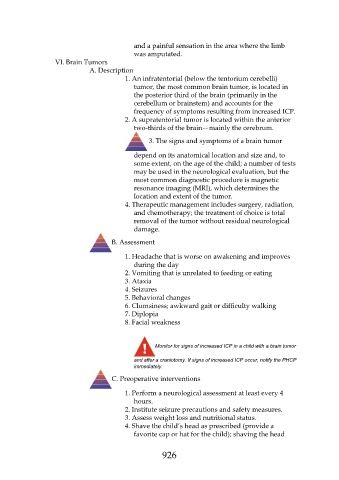Page 926 - Saunders Comprehensive Review For NCLEX-RN
P. 926
and a painful sensation in the area where the limb
was amputated.
VI. Brain Tumors
A. Description
1. An infratentorial (below the tentorium cerebelli)
tumor, the most common brain tumor, is located in
the posterior third of the brain (primarily in the
cerebellum or brainstem) and accounts for the
frequency of symptoms resulting from increased ICP.
2. A supratentorial tumor is located within the anterior
two-thirds of the brain—mainly the cerebrum.
3. The signs and symptoms of a brain tumor
depend on its anatomical location and size and, to
some extent, on the age of the child; a number of tests
may be used in the neurological evaluation, but the
most common diagnostic procedure is magnetic
resonance imaging (MRI), which determines the
location and extent of the tumor.
4. Therapeutic management includes surgery, radiation,
and chemotherapy; the treatment of choice is total
removal of the tumor without residual neurological
damage.
B. Assessment
1. Headache that is worse on awakening and improves
during the day
2. Vomiting that is unrelated to feeding or eating
3. Ataxia
4. Seizures
5. Behavioral changes
6. Clumsiness; awkward gait or difficulty walking
7. Diplopia
8. Facial weakness
Monitor for signs of increased ICP in a child with a brain tumor
and after a craniotomy. If signs of increased ICP occur, notify the PHCP
immediately.
C. Preoperative interventions
1. Perform a neurological assessment at least every 4
hours.
2. Institute seizure precautions and safety measures.
3. Assess weight loss and nutritional status.
4. Shave the child’s head as prescribed (provide a
favorite cap or hat for the child); shaving the head
926

